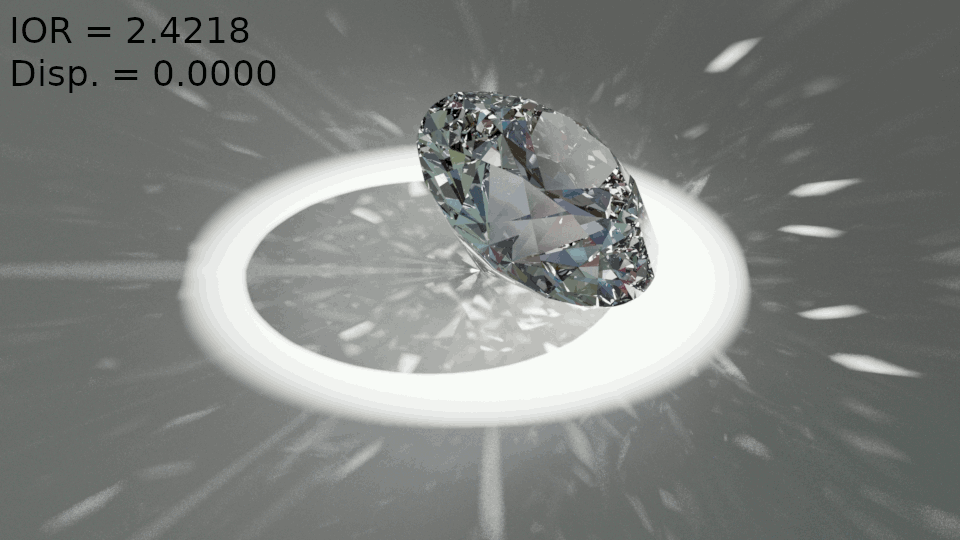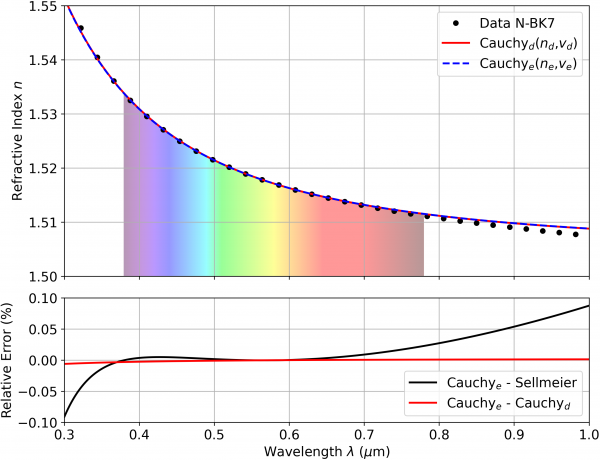Difference between revisions of "Glass Material IOR and Dispersion"
(started work on table; fix Sellmeier typo) |
(Add wikipedia links) |
||
| Line 3: | Line 3: | ||
==Introduction== | ==Introduction== | ||
Glasses have an important property called the Index Of Refraction (IOR). When a light ray encounters a change in IOR, e.g. at the surface of a piece of glass, the direction of the ray is changed according to Snell‘s law: | Glasses have an important property called the [https://en.wikipedia.org/wiki/Refractive_index Index Of Refraction] (IOR). When a light ray encounters a change in IOR, e.g. at the surface of a piece of glass, the direction of the ray is changed according to [https://en.wikipedia.org/wiki/Snell%27s_law Snell‘s law]: | ||
[[File:Snellslaw.png|x20px]]<br> | [[File:Snellslaw.png|x20px]]<br> | ||
| Line 9: | Line 9: | ||
where n<sub>1</sub> and n<sub>2</sub> are the refractive indices outside and inside the glass, and θ<sub>1</sub> and θ<sub>2</sub> the angles between the surface normal vector and the rays outside and inside the glass. | where n<sub>1</sub> and n<sub>2</sub> are the refractive indices outside and inside the glass, and θ<sub>1</sub> and θ<sub>2</sub> the angles between the surface normal vector and the rays outside and inside the glass. | ||
For real materials, the IOR is a function of the wavelength λ of light. This property is called dispersion. For example, the IOR of N-BK7 glass, a common glass for laboratory optics, varies between n = 1.53 at a λ = 400 nm, to n = 1.51 at λ = 800 nm. This may not seem a big difference, but it has significant impact on imaging optics. | For real materials, the IOR is a function of the wavelength λ of light. This property is called [https://en.wikipedia.org/wiki/Dispersion_(optics) dispersion]. For example, the IOR of [https://shop.schott.com/advanced_optics/Products/Optical-Glass/Optical-Glass/Boron-Crown/SCHOTT-N-BK7%C2%AE/c/optical-glass/glass-SCHOTT%20N-BK7%C2%AE N-BK7] glass, a common glass for laboratory optics, varies between n = 1.53 at a λ = 400 nm, to n = 1.51 at λ = 800 nm. This may not seem a big difference, but it has significant impact on imaging optics. | ||
==Quantifying Dispersion== | ==Quantifying Dispersion== | ||
| Line 17: | Line 17: | ||
===The Abbe number=== | ===The Abbe number=== | ||
A very common quantification is the Abbe number, denoted by ν, which is calculated from the refractive index at three differnt wavelengths: | A very common quantification is the [https://en.wikipedia.org/wiki/Abbe_number Abbe number], denoted by ν, which is calculated from the refractive index at three differnt wavelengths: | ||
[[File:abbe_old.png|x28px]] | [[File:abbe_old.png|x28px]] | ||
| Line 33: | Line 33: | ||
===The Cauchy Equation=== | ===The Cauchy Equation=== | ||
The Cauchy equation provides an approximate formula for the dispersion of light. The equation has the following form: | The [https://en.wikipedia.org/wiki/Cauchy%27s_equation Cauchy equation] provides an approximate formula for the dispersion of light. The equation has the following form: | ||
[[File:cauchy_multi.png|x25px]] | [[File:cauchy_multi.png|x25px]] | ||
| Line 53: | Line 53: | ||
===The Sellmeier Equation=== | ===The Sellmeier Equation=== | ||
Like the Cauchy equation, the Sellmeier equation is a formula describing the refractive index as a function of wavelength. It is more complex and suited to describe the refractive index over a wider range of wavelengths: | Like the Cauchy equation, the [https://en.wikipedia.org/wiki/Sellmeier_equation Sellmeier equation] is a formula describing the refractive index as a function of wavelength. It is more complex and suited to describe the refractive index over a wider range of wavelengths: | ||
[[File:sellmeyer.png|x30px]]<br> | [[File:sellmeyer.png|x30px]]<br> | ||
Revision as of 19:04, 28 October 2020
The aim of this article is to present an overview of glass dispersion, how it is quantified and used in the LuxCore glass material to model dispersion, and how to get the correct numbers to use. The focus here is on using the data and models in the physically correct way. For artistic purposes, you may want to deviate from the described methods.
Introduction
Glasses have an important property called the Index Of Refraction (IOR). When a light ray encounters a change in IOR, e.g. at the surface of a piece of glass, the direction of the ray is changed according to Snell‘s law:
where n1 and n2 are the refractive indices outside and inside the glass, and θ1 and θ2 the angles between the surface normal vector and the rays outside and inside the glass.
For real materials, the IOR is a function of the wavelength λ of light. This property is called dispersion. For example, the IOR of N-BK7 glass, a common glass for laboratory optics, varies between n = 1.53 at a λ = 400 nm, to n = 1.51 at λ = 800 nm. This may not seem a big difference, but it has significant impact on imaging optics.
Quantifying Dispersion
There are several common ways to describe, or quantify, the dispersion of a glass:
The Abbe number
A very common quantification is the Abbe number, denoted by ν, which is calculated from the refractive index at three differnt wavelengths:
where the three wavelengths are d = 589.3 nm, F = 486.12 nm and C = 656.27 nm. An alternative definition is based on slightly different wavelengths:
where the three wavelengths are e = 546.07 nm, F‘ = 479.99 nm and C‘ = 643.85 nm.
Important:
a) The Abbe number is an index value derived from three specific data points. As such, it makes no statement on how the refractive index varies between these points.
b) When working with the Abbe number, check which of the two definitions is used.
The Cauchy Equation
The Cauchy equation provides an approximate formula for the dispersion of light. The equation has the following form:
by convention, the wavelength must be used in units of micrometers! The glass material in LuxCore uses only the first two terms of the equation, i.e.
This equation already provides a good fit to many real glasses in the visible spectrum.
Since this form only depends on the two coefficients A and B, it is possible to convert them from a pair of Abbe number and refactive. The conversion algorithm is given below in section Conversion from Abbe Number to Cauchy.
Important:
a) The usual convention, used also by LuxCore, is to calculate with wavelength in units of micrometers.
b) Due to a different naming convention in the reference for the LuxCore implementation, the variables in the source code and tooltipps in BlendLuxCore currently ask for „Cauchy-C“ as the dispersion parameter instead of „Cauchy-B“.
c) The Cauchy-A term is the asymptotical refractive index at high wavelengths. It is therefore smaller than the refractive index at the center of the visible spectrum, which is usually the IOR-value quoted for materials if nothing else is specified.
The Sellmeier Equation
Like the Cauchy equation, the Sellmeier equation is a formula describing the refractive index as a function of wavelength. It is more complex and suited to describe the refractive index over a wider range of wavelengths:
As for the Cauchy equation, further terms could be used. Data sheets for optical glasses usually give the six coefficients of the above form.
Relative Partial Dispersion and Other Quantities
Many more equation and indices have been defined to quantify dispersion, sometimes tailored to specific wavelength ranges.
The concept of relative partial dispersions is similar to the Abbe number, but using another pair of refractive index difference at certain wavelengths in the numerator of the equation.
Even simpler, the refractive index difference between red and blue light is sometimes given. A commonly found example is a dispersion value of 0.044 for Diamond. This is of the same order of magnitude as the Cauchy-B coefficent B = 0.012, and thus often quoted and used.
Dispersion in LuxCore and Tipps
As mentioned in the previous section, LuxCore uses a two-term Cauchy equation to model the refractive index.
Therefore, in (Blend)LuxCore, the correct way to input values is to set the Cauchy-A coefficient as IOR, and the Cauchy-B coefficient as dispersion.
For artistic applications, it should be fine to use the IOR at a visible wavelength instead of the Cauchy-A term. Likewise, a higher dispersion value may be used to compensate for limitations of the rendering process, like SDS caustics or fully specular paths.
The following image shows a comparison of a diamond rendered at with different dispersion values of B = 0 (no dispersion), B = 0.0121 (physically correct) and B = 0.044 (often quoted value). The IOR was adapted so that the refractive index at 550 nm remains constant and the caustics remain centered in the same location.
Conversion from Abbe Number to Cauchy
The Cauchy-coefficents A and B can be calculated from a pair of Abbe number and refractive index, indexed e and d as described in section The Abbe number. First, the Cauchy-B parameter is calculated. The following equation is given for the d-, F- and C-wavelength definition. However, the factor of 0.52 also roughly results with the F'- and C'-wavelengths, so that the equation can be applied in both cases:
With the Cauchy-B parameter, the Cauchy-A parameter can be converted. In this case, slightly different numbers must be used depending on the Abbe-definition. However, the error would be small, as B is small.
The Figure below shows an exmaple plot of data for the N-BK7 optical glass, compared with Cauchy-fits derived from the two Abbe-number definitions in the top panel. The bottom panel shows the relative error between the two definitions, as well as with the much better fitting Sellmeier equation. It can be seen that the error is below 0.05% across the visible spectrum.
Refractive Index and Dispersion Data
A database of raw data for many materials can be found at https://refractiveindex.info/.
Below is a list of a few common materials with the IOR and dispersion settings for BlendLuxCore.
| Material | IOR | Dispersion |
|---|---|---|
| Water | 1.3244 | 0.0031 |
| Window Glass (Soda Lime) | 1.5111 | 0.00425 |
| Lead Crystal Glass | 1.xx | 0.0xx |
| Acrylic | 1.xx | 0.0xx |
| Epoxy Resin | 1.xx | 0.0xx |
| Prism Glass (N-SF11) | 1.7387 | 0.0159 |
| Diamond | 2.3818 | 0.0121 |
Further Reading
Some manufacturers of optical glasses and lens systems have published technical documents that may be helpful to further understand dispersion and how it is measured.
Schott TIE-29: Refractive Index and Dispersion

